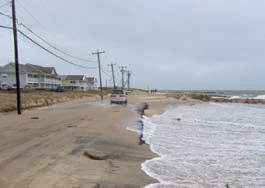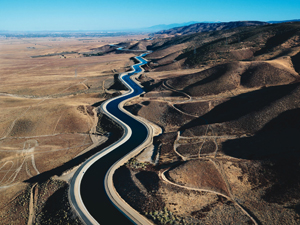Climate Change
Adaptation Overview

Key Points
- Adaptation is the adjustments that society or ecosystems make to limit negative effects of climate change. It can also include taking advantage of opportunities that a changing climate provides.
- Adaptation can include actions by individuals and communities, from a farmer planting more drought-resistant crops to a city ensuring that new coastal infrastructure can accommodate future sea level rise.
- Many governments and organizations across the United States and the world have already begun taking action to adapt to climate change.
- Together, adaptation coupled with actions to reduce greenhouse gas emissions, are needed to address projected climate change.
Related Links
EPA:
- Policy Statement on Climate Change Adaptation
- National Water Program Strategy: Response to Climate Change
- Climate Ready Estuaries
- Climate Ready Water Utilities
Other:
- Interagency Climate Change Adaptation Task Force
- Center for Climate and Energy Solutions: Climate Change 101--Adaptation
- NRC America's Climate Choices: Adapting to the Impacts of Climate Change
- USGCRP Global Climate Change Impacts in the United States
- IPCC: Assessment of Adaptation Practices, Options, Constraints and Capacity
- IPCC: Inter-relationships Between Adaptation and Mitigation
- National Oceanic and Atmospheric Administration (NOAA)
- U.S. Department of the Interior
Key Adaptation Terms
Adaptation - Adjustment in natural or human systems to a new or changing environment that exploits beneficial opportunities or moderates negative effects. [4]
Adaptive capacity - The ability of a system to adjust to climate change (including climate variability and extremes) to moderate potential damages, to take advantage of opportunities, or to cope with the consequences. [4]
Resilience - A capability to anticipate, prepare for, respond to, and recover from significant multihazard threats with minimum damage to social well-being, the economy, and the environment. [4]
Vulnerability - The degree to which a system is susceptible to, or unable to cope with, adverse effects of climate change, including climate variability and extremes. Vulnerability is a function of the character, magnitude, and rate of climate variation to which a system is exposed, its sensitivity, and its adaptive capacity. [4]
“Adaptation” refers to efforts by society or ecosystems to prepare for or adjust to future climate change. These adjustments can be protective (i.e., guarding against negative impacts of climate change), or opportunistic (i.e., taking advantage of any beneficial effects of climate change).
Adaptation to changes in climate is nothing new. Throughout history, human societies have repeatedly demonstrated a strong capacity for adapting to different climates and environmental changes--whether by migration to new areas, changing the crops we cultivate, or building different types of shelter. [1] However, the climate changes we are experiencing now are happening more rapidly than the changes society has experienced in the past. In an increasingly interdependent world, negative effects of climate change on one population or economic sector can have repercussions around the world. [2]
Ecosystems will also be faced with adaptation challenges. Some species will be able to migrate or change their behavior to accommodate changes in climate. Other species may go extinct. Society's ability to anticipate some of the impacts of climate change on ecosystems can help us develop management programs that help ecosystems adapt.
Even if current climate changes seem readily absorbed today, governments and communities are beginning adaptation planning. Many greenhouse gases remain in the atmosphere for 100 years or more after they are emitted. Because of the long-lasting effects of greenhouse gases, those already emitted into the atmosphere will continue to warm Earth in the 21st century, even if we were to stop emitting additional greenhouse gases today. Earth is committed to some amount of future climate change, no matter what. Therefore, steps can be taken now to prepare for, and respond to, the impacts of climate change that are already occurring, and those that are projected to occur in the decades ahead. [2]
There are limits to the ability to adapt, so actions to mitigate climate change must continue. For example, the relocation of communities or infrastructure may not be feasible in many locations, especially in the short term. Over the long term, adaptation alone may not be sufficient to cope with all the projected impacts of climate change. [3] Adaptation will need to be continuously coupled with actions to lower greenhouse gas emissions.
Learn more about current and projected climate change impacts and actions to reduce GHG emissions.
Examples of Adaptation
Adaptation can consist of a wide variety of actions by an individual, community, or organization to prepare for, or respond to, climate change impacts. Many of these measures are things we are already doing but could be stepped up or modified to prepare for climate change. Some examples include:
- Breed crop varieties that are more tolerant of heat, drought, and water logging from heavy rainfall or flooding
- Protect livestock from higher summer temperatures by providing more shade and improving air flow in barns [4]

Rising seas increase risk of damage for coastal properties. Source: NECIA (2007) (PDF)
- Promote shore protection techniques and open space preserves that allow beaches and coastal wetlands to gradually move inland as sea level rises.
- Identify and improve evacuation routes and evacuation plans for low-lying areas, to prepare for increased storm surge and flooding. [4]

Forest and freshwater lake. Source: USGCRP (2009)
- Protect and increase migration corridors to allow species to migrate as the climate changes.
- Promote land and wildlife management practices that enhance ecosystem resilience. [4]
- Increase energy efficiency to help offset increases in energy consumption.
- Harden energy production facilities to withstand increased flood, wind, lightning, and other storm-related stresses. [4]
- Implement early warning systems and emergency response plans to prepare for changes in the frequency, duration, and intensity of extreme weather events.
- Plant trees and expand green spaces in urban settings to moderate heat increases. [4]

Irrigation canal in the desert. Source: USGCRP 2009
- Improve water use efficiency and build additional water storage capacity. [4]
- Protect and restore stream and river banks to ensure good water quality and safe guard water quantity.
Learn more about adaptation in the areas of forests, transportation, and society.
Ongoing Efforts
Efforts by organizations and governments to prepare for climate change impacts have increased significantly across the United States, and the world, in recent years. For example:
- EPA has instituted programs to help communities adapt, including Climate Ready Estuaries and Climate Ready Water Utilities. Learn more about EPA adaptation initiatives.
- The U.S. Interagency Climate Change Adaptation Task Force is coordinating the efforts for adaptation across government agencies. Learn more about Federal government adaptation.
- A growing number of states (e.g., California) and cities (e.g., Chicago) have begun preparing to protect people and infrastructure from climate change impacts. Learn more about local and regional adaptation.
- Many other countries around the world are beginning to adapt. Learn more about international adaptation.
- Additionally, a number of corporations have begun preparing for climate change impacts.
Learn about useful tools for public officials who are planning for climate change.
Resources
[1] Adger, W.N., S. Agrawala, M.M.Q. Mirza, C. Conde, K. O’Brien, J. Pulhin, R. Pulwarty, B. Smit, and K. Takahashi (2007). Assessment of adaptation practices, options, constraints and capacity. In Climate Change 2007: Impacts, Adaptation, and Vulnerability
.
![]() Contribution of Working Group II to the Fourth Assessment Report of the Intergovernmental Panel on Climate Change. Parry, M.L., O.F. Canziani, J.P. Palutikof, P.J. van der Linden, and C.E. Hanson (eds.). Cambridge University Press, Cambridge, UK, 717-743.
Contribution of Working Group II to the Fourth Assessment Report of the Intergovernmental Panel on Climate Change. Parry, M.L., O.F. Canziani, J.P. Palutikof, P.J. van der Linden, and C.E. Hanson (eds.). Cambridge University Press, Cambridge, UK, 717-743.
[2] USGCRP (2009). Global Climate Change Impacts in the United States . Karl, T.R., J.M. Melillo, and T.C. Peterson (eds.). United States Global Change Research Program. Cambridge University Press, New York, NY, USA.
[3] IPCC (2007). Summary for Policymakers. In: Climate Change 2007: Impacts, Adaptation and Vulnerability
.
![]() Contribution of Working Group II to the Fourth Assessment Report of the Intergovernmental Panel on Climate Change. Parry, M.L., O.F. Canziani, J.P. Palutikof, P.J. van der Linden, and C.E. Hanson (eds.). Cambridge University Press, Cambridge, United Kingdom and New York, NY, USA.
Contribution of Working Group II to the Fourth Assessment Report of the Intergovernmental Panel on Climate Change. Parry, M.L., O.F. Canziani, J.P. Palutikof, P.J. van der Linden, and C.E. Hanson (eds.). Cambridge University Press, Cambridge, United Kingdom and New York, NY, USA.
[4] NRC (2010). Adapting to the Impacts of Climate Change
.
![]() National Research Council. The National Academies Press, Washington, DC, USA.
National Research Council. The National Academies Press, Washington, DC, USA.
